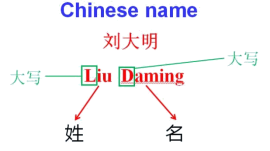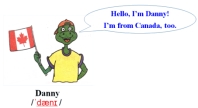

所属成套资源:【冀教版】英语七年级上册 同步教案
- 冀教版英语 七年级上册 Lesson 22 In the Restaurant 教案 教案 1 次下载
- 冀教版英语 七年级上册 Unit 4 Lesson 20 I Like the Supermarket 教案 教案 2 次下载
- 冀教版英语 七年级上册Unit 1 School and Friends Lesson 2 Teacher and Students教案 教案 1 次下载
- 冀教版英语 七年级上册Unit 1 School and Friends Lesson 3 Welcome to Our School教案 教案 1 次下载
- 冀教版英语 七年级上册Unit 1 School and Friends Lesson 5 May I Have a Book教案 教案 1 次下载
冀教版英语 七年级上册Unit 1 School and Friends Lesson 1 Hello教案
展开
这是一份冀教版英语 七年级上册Unit 1 School and Friends Lesson 1 Hello教案,共5页。
Unit 1 School and FriendsLesson 1: Hello!教学目标通过本课节的教学,学生达成以下目标:1.知识目标掌握单词:Canada接触单词:Jenny, Danny, thanks短语和句型:be from, What’s your name? My name is.../I’m...How are you? I’m fine. And you? Nice to meet you, too.2.能力目标(1)学会用英语问候和打招呼; (2)能用英语自我介绍。3.情感目标养成礼貌问候他人的好习惯。重点难点1.重点:掌握本课节的英语问候语和打招呼用语。 2.难点:能用英语自我介绍。教学准备PPT 课件;本课节用到的录音。授课时数1课时教学过程Step 1 Warming upHave a free talk.The teacher introduces himself/herself. Write his/her name on the blackboard. Say: Hello. Welcome to my English class. I’m/My name is… (Liu Daming). What’s your name?Ask the students’ names one by one.Step 2 Presentation 1. Present how to say and write Chinese names in English.Chinese names are made up of surnames and given names. Write them separately, and the first letters of surnames and given names are written in capital letters.
 2. Teach the new phrase and sentences.(1) Teach be from using the picture. I’m Liu Daming. I am from China. be from…来自……(2) Teach —What’s your name? —I’m/My name is…Step 3 PracticePractice the following conversation in pairs.A: Hello, I’m...! I’m from China. What’s your name?B: Hello, I’...! I’m from China, too.Step 4 PresentationTeach the words: Canada, Jenny, Danny using the pictures.
2. Teach the new phrase and sentences.(1) Teach be from using the picture. I’m Liu Daming. I am from China. be from…来自……(2) Teach —What’s your name? —I’m/My name is…Step 3 PracticePractice the following conversation in pairs.A: Hello, I’m...! I’m from China. What’s your name?B: Hello, I’...! I’m from China, too.Step 4 PresentationTeach the words: Canada, Jenny, Danny using the pictures.
 Step 5 Listening, reading and acting (Part 1)1. Play the recording of Part 1 for the students to listen and read following it.2. Get the class to read the sentences by themselves.3. Act it out in group of three.Step 6 Presentation1. Show the conversation between teacher and a student. T: What’s your name?S: I’m...T: How are you?S: I’m fine. And you?T: I’m good, thanks. Nice to meet you.S: Nice to meet you, too.2. Explain some sentences for the class.I’m... = My name is...I’m fine. = I’m good.And you? = And how are you?thanks = thank youNice to meet you.的答语为Nice to meet you, too.Step 7 PracticeGet the class to make the conversation like this and practice it.A: Hello! I’m... I’m from... What’s your name?B: Hi! I’m... I’m from..., too.A: How are you?B: I’m fine/good. And you?A: I’m fine/good, thanks. Nice to meet you.B: Nice to meet you, too.Step 8 Listening, reading and acting (Part 2)1. Play the recording of Part 2 for the class to listen and read following it.2. Practice the conversation in pairs.3. Act out the conversation in front of the class.Step 9 Listening and singing1. Play the recording of Exercise 1 in Let’s Do It! for the class to listen and sing along together. Make sure the class can sing it by themselves.2. Change the names Joe and Sue into their own names, then sing it.Step 10 Playing a gamePlay the game Stop and Go. Play this game to practice greeting your friends.A: Hello! My name is... What’s your name?B: Hi! My name is... How are you?A: I’m fine. Nice to meet you!Step 11 Numbering the sentencesGet the class to finish the Exercise 3 in Let’s Do It! Then check them.Answers (自上而下): 2 1 3 Step 12 SummarySum up what we’ve learnt in this period with the class.1. Hello, I’m...2. I’m from...3. A: What’s your name?B: My name is...4. A: How are you?B: Fine, thanks. 5. A: Nice to meet you.B: Nice to meet you, too.Step 13 Language points1. I’m from China. 我来自中国。be from...来自……
Step 5 Listening, reading and acting (Part 1)1. Play the recording of Part 1 for the students to listen and read following it.2. Get the class to read the sentences by themselves.3. Act it out in group of three.Step 6 Presentation1. Show the conversation between teacher and a student. T: What’s your name?S: I’m...T: How are you?S: I’m fine. And you?T: I’m good, thanks. Nice to meet you.S: Nice to meet you, too.2. Explain some sentences for the class.I’m... = My name is...I’m fine. = I’m good.And you? = And how are you?thanks = thank youNice to meet you.的答语为Nice to meet you, too.Step 7 PracticeGet the class to make the conversation like this and practice it.A: Hello! I’m... I’m from... What’s your name?B: Hi! I’m... I’m from..., too.A: How are you?B: I’m fine/good. And you?A: I’m fine/good, thanks. Nice to meet you.B: Nice to meet you, too.Step 8 Listening, reading and acting (Part 2)1. Play the recording of Part 2 for the class to listen and read following it.2. Practice the conversation in pairs.3. Act out the conversation in front of the class.Step 9 Listening and singing1. Play the recording of Exercise 1 in Let’s Do It! for the class to listen and sing along together. Make sure the class can sing it by themselves.2. Change the names Joe and Sue into their own names, then sing it.Step 10 Playing a gamePlay the game Stop and Go. Play this game to practice greeting your friends.A: Hello! My name is... What’s your name?B: Hi! My name is... How are you?A: I’m fine. Nice to meet you!Step 11 Numbering the sentencesGet the class to finish the Exercise 3 in Let’s Do It! Then check them.Answers (自上而下): 2 1 3 Step 12 SummarySum up what we’ve learnt in this period with the class.1. Hello, I’m...2. I’m from...3. A: What’s your name?B: My name is...4. A: How are you?B: Fine, thanks. 5. A: Nice to meet you.B: Nice to meet you, too.Step 13 Language points1. I’m from China. 我来自中国。be from...来自……![]()
![]() 地点 来自某地(某地方人) 某人 来自某人(某人给/送的)My teacher is from Hebei.我老师来自河北。The pen is from my brother.这支钢笔是我哥哥给的。2. How are you?你好吗?How are you?意为“你(身体)好吗?”,是熟人或朋友见面时常用的客套语,用来询问对方的身体状况,常见的答语有“Fine(I’m fine/I’m OK/I’m all right), thank you/thanks”。有时为了表示礼貌,后面还加上一句“And you (= And how are you)?”。原问话人常回答“I’m fine, too.”“I’m OK.”或“I’m good.”等。3. I’m good, thanks.我很好,谢谢。thanks 谢谢;相当于thank you。当有人向我们表示问候、提供帮助或夸奖我们时,我们要表示感谢,常说Thanks.或Thank you.—Hello, Jenny! How are you? 喂,詹妮!你好吗?—Fine, thanks/thank you.很好,谢谢。—Danny, your coat is very nice.丹妮,你的上衣很好。—Thanks./Thank you.谢谢。【拓展】表示感谢的常用语:Thank you very much.非常感谢。Thanks a lot.多谢。Many thanks. 多谢。4. Nice to meet you.见到你很高兴。Nice to meet you.是陌生人初次见面时的客套话,常用于第三人介绍之后。也可用于双方许久未见后偶尔相逢场合,表达一种高兴的心情。回答时通常用“Nice to meet you, too.”,意为“见到你我也很高兴”。—Hello! I’m Wang Ping. Nice to meet you.你好!我叫王平。见到你很高兴。—Nice to meet you, too.见到你我也很高兴。【拓展】Nice to do sth.很高兴做某事。Nice to have a good friend.很高兴有个好朋友。Step 14 Homework1. Remember the new words and expressions learnt in this lesson.2. Recite Part 2 How are you?3. Preview Lesson 2.当堂达标根据提示完成对话。A: Hello, Jenny. I’m Li Ming. I’m _______ China.B: Hi, Li Ming. I’m from ________ (加拿大). How are you?A: I’m fine, ________ (thank). And you?B: I’m g_______. Nice to meet you.A: Nice to meet you, _______.答案: from; Canada; thanks; good; too板书设计UNIT 1 School and FriendsLesson 1: Hello!Canada thanksbe from 1. —What’s your name? —My name is.../I’m...2. —How are you? —I’m fine. And you? —I’m good/fine.3. —Nice to meet you.—Nice to meet you, too.
地点 来自某地(某地方人) 某人 来自某人(某人给/送的)My teacher is from Hebei.我老师来自河北。The pen is from my brother.这支钢笔是我哥哥给的。2. How are you?你好吗?How are you?意为“你(身体)好吗?”,是熟人或朋友见面时常用的客套语,用来询问对方的身体状况,常见的答语有“Fine(I’m fine/I’m OK/I’m all right), thank you/thanks”。有时为了表示礼貌,后面还加上一句“And you (= And how are you)?”。原问话人常回答“I’m fine, too.”“I’m OK.”或“I’m good.”等。3. I’m good, thanks.我很好,谢谢。thanks 谢谢;相当于thank you。当有人向我们表示问候、提供帮助或夸奖我们时,我们要表示感谢,常说Thanks.或Thank you.—Hello, Jenny! How are you? 喂,詹妮!你好吗?—Fine, thanks/thank you.很好,谢谢。—Danny, your coat is very nice.丹妮,你的上衣很好。—Thanks./Thank you.谢谢。【拓展】表示感谢的常用语:Thank you very much.非常感谢。Thanks a lot.多谢。Many thanks. 多谢。4. Nice to meet you.见到你很高兴。Nice to meet you.是陌生人初次见面时的客套话,常用于第三人介绍之后。也可用于双方许久未见后偶尔相逢场合,表达一种高兴的心情。回答时通常用“Nice to meet you, too.”,意为“见到你我也很高兴”。—Hello! I’m Wang Ping. Nice to meet you.你好!我叫王平。见到你很高兴。—Nice to meet you, too.见到你我也很高兴。【拓展】Nice to do sth.很高兴做某事。Nice to have a good friend.很高兴有个好朋友。Step 14 Homework1. Remember the new words and expressions learnt in this lesson.2. Recite Part 2 How are you?3. Preview Lesson 2.当堂达标根据提示完成对话。A: Hello, Jenny. I’m Li Ming. I’m _______ China.B: Hi, Li Ming. I’m from ________ (加拿大). How are you?A: I’m fine, ________ (thank). And you?B: I’m g_______. Nice to meet you.A: Nice to meet you, _______.答案: from; Canada; thanks; good; too板书设计UNIT 1 School and FriendsLesson 1: Hello!Canada thanksbe from 1. —What’s your name? —My name is.../I’m...2. —How are you? —I’m fine. And you? —I’m good/fine.3. —Nice to meet you.—Nice to meet you, too.







